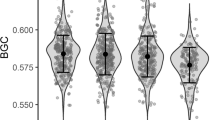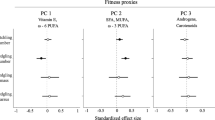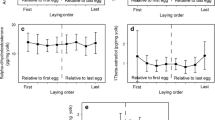Abstract
Mothers may profoundly affect offspring phenotype and performance by adjusting egg components, including steroid hormones. We studied the effects of elevated prenatal testosterone (T) exposure in the ring-necked pheasant on the expression of a suite of male and female traits, including perinatal response to stress, immune response, growth, and secondary sexual traits. Prenatal T levels were increased by injecting the yolk of unincubated eggs with physiological doses of the hormone. Yolk T injection resulted in a reduced length of male tarsal spurs, a trait which positively predicts male success in intra- and intersexual selection and viability, whereas no direct effect on male wattle characteristics or plumage traits of either sex was observed. Female spur length was also negatively affected by T, but to a lesser extent than in males. In addition, the covariation between male secondary sexual traits, which are reliable quality indicators, differed between T and control males, suggesting that the manipulation may have altered the assessment of overall male quality by other males and females. In conclusion, the negative effects of elevated yolk T on spur length, a trait which positively predicts male fitness, coupled with the lack of effects on growth or other traits in both sexes, provided limited evidence for mothers being subjected to a trade-off between positive and negative consequences of yolk T deposition on offspring traits and suggest that directional selection for reduced yolk T levels may occur in the ring-necked pheasant.


Similar content being viewed by others
References
Adkins-Regan E, Ottinger MA, Park J (1995) Maternal transfer of estradiol to egg yolks alters sexual differentiation of avian offspring. J Exp Zool 271:466–470
Andersson S, Pryke SR, Örnborg J, Lawes MJ, Andersson M (2002) Multiple receivers, multiple ornaments, and a trade-off between agonistic and epigamic signaling in a widowbird. Am Nat 160:683–691
Andersson S, Uller T, Lõhmus M, Sundström F (2004) Effects of egg yolk testosterone on growth and immunity in a precocial bird. J Evol Biol 17:501–505
Badyaev AV (2002) Growing apart: an ontogenetic perspective on the evolution of sexual size dimorphism. Trends Ecol Evol 17:369–378
Baratti M, Alberti A, Groenen M, Veenendaal T, Dessì-Fulgheri F (2001) Polymorphic microsatellites developed by cross-species amplifications in common pheasant breeds. Anim Genet 32:222–225
Becker JB, Breedlove SM, Crews D (1992) Behavioral endocrinology. MIT Press, Cambridge
Belliure J, Smith L, Sorci G (2004) Effect of testosterone on T cell-mediated immunity in two species of Mediterranean lacertid lizards. J Exp Zool 301A:411–418
Berglund A, Bisazza A, Pilastro A (1996) Armaments and ornaments: an evolutionary explanation of traits of dual utility. Biol J Linn Soc 58:385–399
Biadi F, Mayot P (1990) Les faisans. Hatier, Paris
Brandstetter AM, Pfaffl MW, Hocquette JF, Gerrard DE, Picard B, Geay Y, Sauerwein H (2000) Effects of muscle type, castration, age, and compensatory growth rate on androgen receptor mRNA expression in bovine skeletal muscle. J Anim Sci 78:629–637
Briganti F, Papeschi A, Mugnai T, Dessì-Fulgheri F (1999) Effect of testosterone on male traits and behaviour in juvenile pheasants. Ethol Ecol Evol 11:171–178
Caldwell Hahn D, Hatfield JS, Abdelnabi MA, Wu JM, Igl LD, Ottinger MA (2005) Inter-species variation in yolk steroid levels and a cowbird-host comparison. J Avian Biol 36:40–46
Chowen JA, Garcia Segura LM, Gonzalez Parra S, Argente J (1996) Sex steroid effects on the development and functioning of the growth hormone axis. Cell Mol Neurobiol 16:297–310
Cramp S (1998) The complete birds of the Western Palearctic on CD-ROM. Oxford University Press, Oxford
Duffy DL, Bentley GE, Drazen DL, Ball GF (2000) Effects of testosterone on cell-mediated and humoral immunity in non-breeding adult European starlings. Behav Ecol 6:654–662
Dufty AM Jr, Clobert J, Møller AP (2002) Hormones, developmental plasticity and adaptation. Trends Ecol Evol 17:190–196
Eising CM, Eikenaar C, Schwabl H, Groothuis TGG (2001) Maternal androgens in black-headed gull (Larus ridibundus) eggs: consequences for chick development. Proc R Soc Lond B Biol Sci 268:839–846
Eising CM, Groothuis TGG (2003) Yolk androgens and begging behaviour in black-headed gull chicks: an experimental field study. Anim Behav 66:1027–1034
Erhard HW, Mendl M, Christiansen SB (1999) Individual differences in tonic immobility may reflect behavioural strategies. Appl Anim Behav Sci 64:31–46
Folstad I, Karter AJ (1992) Parasites, bright males, and the immunocompetence handicap. Am Nat 139:603–622
Gallup GG (1977) Tonic immobility: the role of fear and predation. Psychol Rec 27:41–61
Gatford KL, Egan AR, Clarke IJ, Owens PC (1998) Sexual dimorphism of the somatotrophic axis. J Endocrinol 157:373–389
Gil D (2003) Golden eggs: maternal manipulation of offspring phenotype by egg androgen in birds. Ardeola 50:281–294
Glick B (1984) Interrelation of the avian immune and neuroendocrine systems. J Exp Zool 232:671–682
Göransson G, von Schantz T, Fröberg I, Helgée A, Wittzell H (1990) Male characteristics, viability and harem size in the pheasant, Phasianus colchicus. Anim Behav 40:89–104
Groothuis TGG, Müller W, von Engelhardt N, Carere C, Eising CM (2005a) Maternal hormones as a tool to adjust offspring phenotype in avian species. Neurosci Biobehav Rev 29:329–352
Groothuis TGG, Eising CM, Dijkstra C, Müller W (2005b) Balancing between costs and benefits of maternal hormone deposition in avian eggs. Biol Lett 1:78–81
Grossman CJ (1984) Regulation of the immune system by sex steroids. Endocr Rev 5:435–455
Henry MH, Burke WH (1999) The effects of in ovo administration of testosterone or an antiandrogen on growth of chick embryos and embryonic muscle characteristics. Poult Sci 78:1006–1013
Hill DA, Robertson P (1988) The pheasant. Ecology, management and conservation. BSP Professional Books, Oxford
Hirota Y, Suzuki T, Chazono Y, Bito Y (1976) Humoral immune responses characteristic of testosterone-propionate-treated chickens. Immunology 30:341–348
Jones RB (1986) The tonic immobility reaction of the domestic fowl: a review. Worlds Poult Sci J 42:82–96
Jones RB (1989) Chronic stressors, tonic immobility and leucocyticresponses in the domestic fowl. Physiol Behav 46:439–442
Kamegai J, Wakabayashi I, Kineman RD, Frohman LA (1999) Growth hormone-releasing hormone receptor (GHRH-R) and growth hormone secretagogue receptor (GHS-R) mRNA levels during postnatal development in male and female rats. J Neuroendocrinol 11:299–306
Lipar JL, Ketterson ED (2000) Maternally derived yolk testosterone enhances the development of the hatching muscle in the red-winged blackbird Agelaius phoeniceus. Proc R Soc Lond B Biol Sci 267:2005–2010
Lochmiller RL, Vestey MR, Boren JC (1993) Relationship between protein nutritional-status and immunocompetence in northern bobwhite chicks. Auk 110:503–510
Lopez ME, Hargis BM, Dean CE, Porter TE (1995) Uneven regional distributions of prolactin- and growth hormone-secreting cells and sexually dimorphic proportions of prolactin secretors in the adenohypophysis of adult chickens. Gen Comp Endocrinol 100:246–254
Mateos C (1998) Sexual selection in the ring-necked pheasant: a review. Ethol Ecol Evol 10:313–332
Mateos C, Carranza J (1995) Female choice for morphological features of male ring-necked pheasants. Anim Behav 49:737–748
Mateos C, Carranza J (1996) On the intersexual selection for spurs in the ring-necked pheasant. Behav Ecol 7:362–369
Mateos C, Carranza J (1997) Signals in intra-sexual competition between ring-necked pheasant males. Anim Behav 53:471–485
Meriggi A (1992) Fagiano (Phasianus colchicus). In: Brichetti P, De Franceschi P, Baccetti N (eds) Fauna d'Italia, Aves I. Calderini Edizioni, Bologna, pp 824–840
Møller AP, Pomiankowski A (1993) Why have birds got multiple sexual ornaments? Behav Ecol Sociobiol 32:167–176
Mousseau TA, Fox CW (1998) The adaptive significance of maternal effects. Trends Ecol Evol 13:403–407
Navara KJ, Hill GE, Mendonça MT (2005) Variable effects of yolk androgens on the growth and immunity in bluebird nestlings. Physiol Biochem Zool 78:570–578
Ohlsson T, Smith HG, Råberg L, Hasselquist D (2002) Pheasant sexual ornaments reflect nutritional conditions during early growth. Proc R Soc Lond B Biol Sci 269:21–27
Ohlsson T, Smith HG, Råberg L, Hasselquist D (2003) Effects of nutrition on sexual ornaments and humoral immune responsiveness in adult male pheasants. Ethol Ecol Evol 15:31–42
Owens IPF, Short RV (1995) Hormonal basis of sexual dimorphism in birds: implications for new theories of sexual selection. Trends Ecol Evol 10:44–46
Papeschi A, Briganti F, Dessì-Fulgheri F (2000) Winter androgen levels and wattle size in male common pheasants. Condor 102:193–197
Papeschi A, Carroll JP, Dessì-Fulgheri F (2003) Wattle size is correlated with male territorial rank in juvenile ring-necked pheasants. Condor 105:362–366
Price T (1998) Maternal and paternal effects in birds: effects on offspring fitness. In: Mousseau TA, Fox CW (eds) Maternal effects as adaptations. Oxford University Press, New York, pp 202–226
Romano M, Rubolini D, Martinelli R, Bonisoli Alquati A, Saino N (2005) Experimental manipulation of yolk testosterone affects digit length ratios in the ring-necked pheasant (Phasianus colchicus). Horm Behav 48:342–346
Romanoff AL (1960) The avian embryo. Macmillan, New York
Rubolini D, Romano M, Boncoraglio G, Ferrari RP, Martinelli R, Galeotti P, Fasola M, Saino N (2005) Effects of elevated egg corticosterone levels on behavior, growth, and immunity of yellow-legged gull (Larus michahellis) chicks. Horm Behav 47:592–605
Rubolini D, Romano M, Martinelli R, Saino N (in press) Effects of elevated yolk testosterone levels on survival, growth and immunity of male and female yellow-legged gull chicks. Behav Ecol Sociobiol
Rutkowska J, Cichón M, Puerta M, Gil D (2005) Negative effects of elevated testosterone on female fecundity in zebra finches. Horm Behav 47:585–591
Saino N, Calza S, Møller AP (1997) Immunocompetence of nestling barn swallows in relation to brood size and parental effort. J Anim Ecol 66:827–836
Saino N, Ferrari RP, Romano M, Martinelli R, Lacroix A, Gil D, Møller AP (in press) Maternal allocation of androgens and antagonistic effects of yolk androgens on sons and daughters. Behav Ecol
Schwabl H (1993) Yolk is a source of maternal testosterone for developing birds. Proc Natl Acad Sci U S A 90:11446–11450
Schwabl H (1996) Maternal testosterone in the avian egg enhances postnatal growth. Comp Biochem Physiol A 114:271–276
Searcy WA (1988) Do female red-winged blackbirds limit their own breeding densities? Ecology 69:85–95
Sockman KW, Schwabl H (2000) Yolk androgens reduce offspring survival. Proc R Soc Lond B Biol Sci 267:1451–1456
Sokal RR, Rohlf FJ (1995) Biometry, 3rd edn. Freeman, San Francisco
Staub NL, De Beer M (1997) The role of androgens in female vertebrates. Gen Comp Endocrinol 108:1–24
Strasser R, Schwabl H (2004) Yolk testosterone organizes behavior and male plumage coloration in house sparrows (Passer domesticus). Behav Ecol Sociobiol 56:491–497
Uller T, Eklöf J, Andersson S (2005) Female egg investment in relation to male sexual traits and the potential for transgenerational effects in sexual selection. Behav Ecol Sociobiol 57:584–590
Veldhuis JD, Iranmanesh A (1996) Physiological regulation of the human growth hormone (GH)-insulin-like growth factor type I (IGF-I) axis: predominant impact of age, obesity, gonadal function, and sleep. Sleep 19:221–224
Villafuerte J, Negro JJ (1998) Digital imaging for colour measurement in ecological research. Ecol Lett 1:151–154
von Engelhardt N, Dijkstra C, Daan S, Groothuis TGG (2004) Effects of 17-beta-estradiol treatment of female zebra finches on offspring sex ratio and survival. Horm Behav 45:306–313
von Schantz T, Göransson G, Andersson G, Fröberg I, Grahn M, Helgée A, Wittzell H (1989) Female choice selects for a viability-based trait in pheasants. Nature 337:166–169
Wade MJ (1998) The evolutionary genetics of maternal effects. In: Mousseau TA, Fox CW (eds) Maternal effects as adaptations. Oxford University Press, New York, pp 5–21
Williams TD (1994) Intraspecific variation in egg size and egg composition in birds: effects on offspring fitness. Biol Rev Camb Philos Soc 68:35–59
Williams TD (1999) Parental and first generation effects of exogenous 17-beta-estradiol on reproductive performance of female zebra finches (Taeniopygia guttata). Horm Behav 35:135–143
Wolf JB, Brodie ED, Cheverud JM, Moore AJ, Wade MJ (1998) Evolutionary consequences of indirect genetic effects. Trends Ecol Evol 13:64–69
Acknowledgements
We warmly thank all the people that helped us with handling and measurement of pheasants, E. Collado for advice on color measurements, N. von Engelhardt, and two referees for useful comments on the manuscript.
Author information
Authors and Affiliations
Corresponding author
Additional information
Communicated by J. Graves
Rights and permissions
About this article
Cite this article
Rubolini, D., Romano, M., Martinelli, R. et al. Effects of prenatal yolk androgens on armaments and ornaments of the ring-necked pheasant. Behav Ecol Sociobiol 59, 549–560 (2006). https://doi.org/10.1007/s00265-005-0080-1
Received:
Revised:
Accepted:
Published:
Issue Date:
DOI: https://doi.org/10.1007/s00265-005-0080-1




